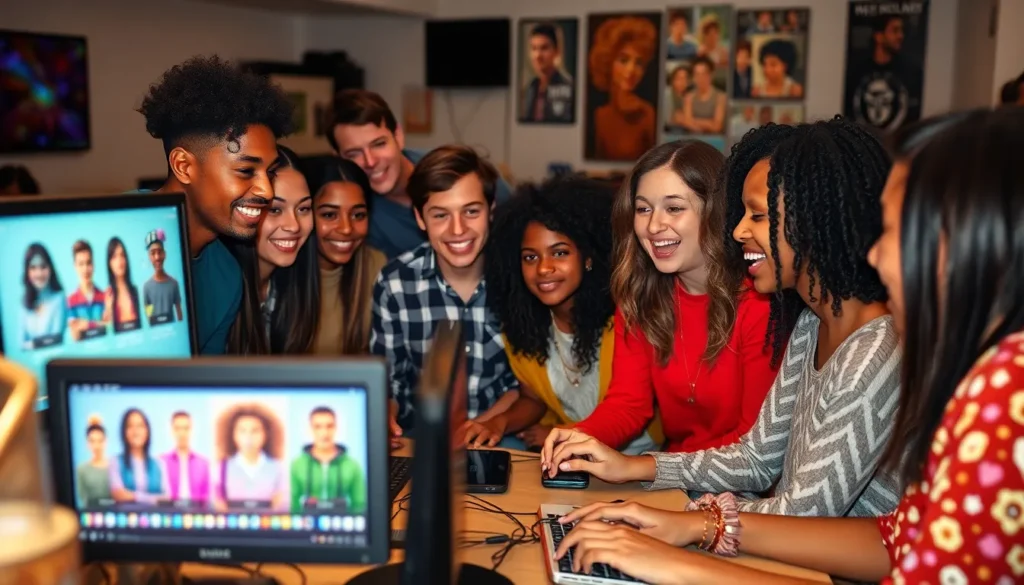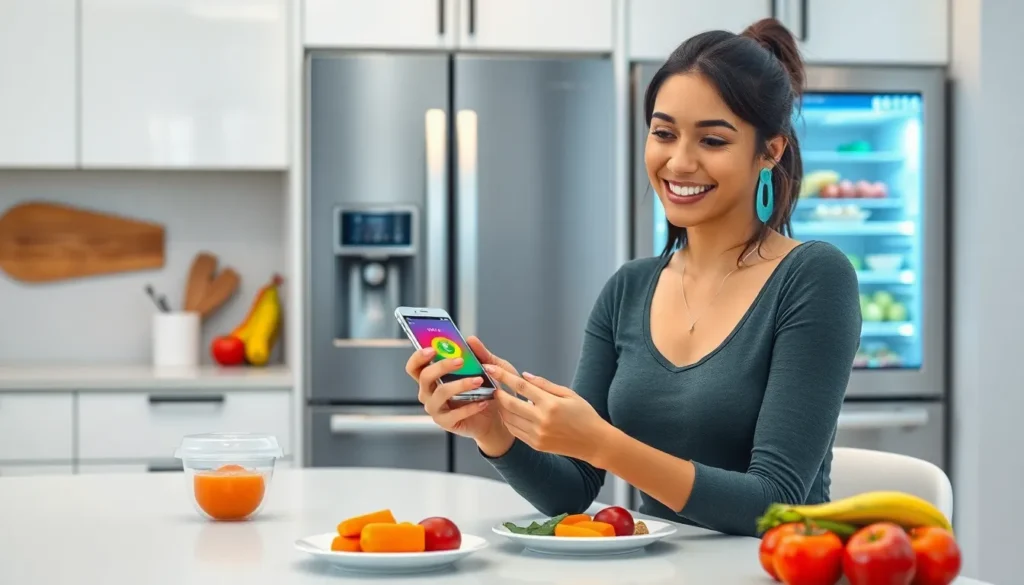Table of Contents
ToggleIn today’s fast-paced world, technology isn’t just a luxury—it’s a necessity. From the moment the alarm clock blares to when the last scroll through social media happens at night, technology weaves itself into the fabric of daily life. It’s like that friend who never leaves your side, always ready to help, entertain, or sometimes just distract you with cat videos.
Overview of Technology in Daily Life
Technology permeates various aspects of daily life, influencing how individuals interact, work, and play. Devices, like smartphones and tablets, connect users to information and each other instantly. Communication tools, such as emails and messaging apps, have transformed the way people share ideas and collaborate in real time.
Daily routines often rely on technology for efficiency. Smart home devices automate tasks, providing conveniences like adjusting lighting or temperature with voice commands. Fitness trackers monitor health metrics, guiding users toward healthier lifestyles and helping them achieve fitness goals.
Entertainment options further illustrate technology’s impact. Streaming services allow access to vast libraries of movies and music, catering to diverse tastes and preferences. Online gaming connects players from different locations, creating communities and fostering friendships.
Shopping has also evolved with technology. E-commerce platforms offer users the ability to purchase goods from anywhere, often with just a few clicks. Social media platforms showcase products, making it easier for consumers to discover trends and make informed decisions.
Transportation technology enhances travel experiences. Navigation apps provide real-time traffic updates, helping users avoid congestion and reach destinations quicker. Ridesharing services offer convenient alternatives to traditional taxis, increasing flexibility in transportation options.
Education increasingly integrates technology as well. Online courses and learning platforms enable students to study at their own pace, expanding access to knowledge. Interactive tools, like virtual simulations, enhance understanding and engagement in various subjects.
Overall, technology has become indispensable, shaping routines and enhancing lives in countless ways. Each technological advance brings opportunities for growth, connection, and convenience, further intertwining with everyday activities.
Communication

Technology enhances communication significantly in daily life. Users connect globally, breaking barriers with ease and speed.
Social Media Platforms
Social media platforms revolutionize interpersonal communication. Facebook, Instagram, and Twitter facilitate sharing life updates, thoughts, and images instantly. Millions of users engage with diverse content, fostering communities around interests and events. These platforms enable businesses to connect with customers effectively, enhancing brand visibility and user interaction. Real-time feedback helps brands adjust strategies quickly, whether for promotions or customer service.
Instant Messaging Apps
Instant messaging apps transform conversations into real-time exchanges. Applications like WhatsApp, Telegram, and Signal allow users to share messages, photos, and videos instantly. Group chats cultivate discussions among friends, families, and colleagues. Enhanced encryption prioritizes user privacy, securing conversations from prying eyes. Voice and video calling features foster deeper connections, enabling face-to-face interactions despite physical distance. Notifications ensure users stay updated, making communication more accessible than ever.
Education
Technology significantly enhances education through various tools and platforms. Learners now access vast knowledge from anywhere at any time.
Online Learning Resources
Online platforms provide courses and tutorials that cater to diverse subjects. Websites like Coursera and Khan Academy offer free and paid content, enabling users to learn at their own pace. Students can explore video lectures, interactive quizzes, and discussion forums to deepen their understanding. Moreover, these resources support a flexible learning environment, making it easier for busy individuals to balance education with other commitments.
Educational Apps
Educational apps enrich the learning experience by offering engaging content. Applications like Duolingo and Quizlet foster language acquisition and knowledge retention. Users can practice skills through gamified experiences and personalized learning paths. Innovative features such as progress tracking and social sharing promote continued motivation. Additionally, these apps encourage collaboration, allowing users to connect with peers for study support.
Health and Fitness
Technology enhances health and fitness in significant ways. It provides tools that empower individuals to monitor and improve their well-being.
Wearable Technology
Wearable technology includes devices like smartwatches and fitness trackers. These gadgets track various health metrics, including heart rate, steps, and sleep patterns. Data collected offers insights into physical activity and sleep quality. Users can set specific goals, motivating them to maintain active lifestyles. Many wearables sync with smartphones for real-time updates and trend analysis. These connected devices promote accountability and ensure users stay informed about their health.
Health Monitoring Apps
Health monitoring apps play a crucial role in personal well-being. Apps such as MyFitnessPal and Fitbit allow users to log meals and exercise easily. Users often receive personalized feedback on their dietary choices and fitness habits. Many apps provide community features, enabling connection with friends for added motivation. Tracking progress visually through charts and graphs keeps users engaged. Real-time notifications help users stay on target with their health objectives.
Transportation
Technology fundamentally changes how people navigate their environments. It simplifies travel and enhances overall commuting experiences.
Navigation Apps
Navigation apps like Google Maps and Waze provide real-time traffic updates. Users benefit from turn-by-turn directions and alternative routes during congested travel times. Features such as estimated arrival times allow for better planning. Many apps also offer public transit options, promoting eco-friendly travel. Accessing satellite imagery helps users visualize their routes. Vehicle integration enhances usability by syncing with car systems. Frequent updates keep maps accurate and reliable, ensuring users receive the latest information.
Rideshare Services
Rideshare services such as Uber and Lyft revolutionize personal transportation. Passengers can summon rides directly from their smartphones. The flexibility of choosing different vehicle types caters to varying needs. Users benefit from cashless payments, making transactions seamless. Ratings allow for transparency and driver accountability. Ridesharing encourages carpooling, which reduces traffic congestion and carbon emissions. The convenience of schedule adjustments accommodates last-minute plans. These services expand transportation options beyond traditional taxis, increasing urban mobility.
Entertainment
Technology significantly shapes entertainment options in daily life, enhancing experiences and providing diverse content across various platforms.
Streaming Services
Streaming services have transformed how people consume media. Platforms such as Netflix, Hulu, and Disney+ offer vast libraries of movies, TV shows, and documentaries. Instant access to a wide range of entertainment keeps users engaged, allowing them to watch their favorite content at their convenience. Additionally, original programming on these platforms often attracts critical acclaim and creates cultural phenomena. Smart devices enable seamless streaming experiences, ensuring viewers enjoy high-quality visuals and sound. Personalized recommendations enhance user satisfaction, tailoring choices based on viewing habits.
Gaming
Gaming represents another evolving facet of entertainment technology. The rise of consoles like PlayStation and Xbox has fostered immersive gaming experiences, while mobile games offer convenience and accessibility. Online multiplayer games create communities that connect players worldwide, promoting social interaction. Esports has emerged as a competitive platform, attracting large audiences and sponsorship deals. Innovations like virtual reality (VR) enhance gameplay, providing sensory engagement that immerses users in virtual worlds. Mobile gaming apps cater to casual players, offering quick and enjoyable experiences that fit into busy schedules.
Home Automation
Home automation streamlines daily tasks, improving convenience and efficiency. Smart devices integrate seamlessly into households, creating an interconnected ecosystem.
Smart Home Devices
Smart home devices serve multiple functions, enhancing everyday living. Thermostats like the Nest adjust temperatures automatically based on individual preferences and schedules. Voice-activated assistants, such as Amazon Echo or Google Home, allow users to control lights, music, and appliances through simple voice commands. Smart lighting systems provide customizable settings and programs, enabling ambiance adjustments with minimal effort. Appliances like refrigerators, ovens, or washing machines also become smarter, allowing users to monitor and control them remotely. Together, these devices contribute to energy management and overall lifestyle efficiency, ensuring comfort in the home environment.
Security Systems
Security systems play a crucial role in protecting homes and families. Smart cameras provide real-time video monitoring, sending alerts directly to users’ smartphones. Features such as motion detection allow for immediate responses to potential threats. Doorbell cameras enhance security further by enabling two-way communication with visitors, fostering peace of mind. Alarm systems connected to mobile apps offer remote control of security settings, ensuring users can monitor their homes from anywhere. Integration with smart locks enables controlled access, strengthening home security through personalized entry codes for family members or visitors.
Productivity
Technology significantly boosts productivity in daily life through various tools and platforms. Individuals and teams leverage these advancements to streamline their tasks efficiently.
Task Management Tools
Task management tools like Trello, Asana, and Microsoft To Do help individuals organize their projects. These applications facilitate tracking progress through easy-to-use interfaces. Users can create to-do lists, set deadlines, and assign tasks, enhancing team collaboration. Notifications alert team members about important updates and deadlines. Visual boards in tools like Trello provide a clear overview of ongoing projects. Prioritizing tasks becomes straightforward when using established systems to categorize responsibilities.
Remote Work Technologies
Remote work technologies revolutionize professional life, enabling seamless collaboration across distances. Platforms such as Zoom and Microsoft Teams foster effective communication through video conferencing features. Shared documents in Google Workspace allow for simultaneous editing, enhancing team productivity. Virtual whiteboards, like Miro, promote brainstorming sessions that spark creativity. Quick access to cloud storage solutions ensures that files are available whenever needed. When combined with task management tools, remote work technologies create an integrated environment that supports flexibility and efficiency.
Financial Management
Technology plays a vital role in managing finances efficiently. Numerous tools exist to simplify banking and budgeting.
Banking Apps
Banking apps streamline financial transactions, making managing accounts easy. Users access account balances, transfer funds, and pay bills with a few taps. Popular apps like Chase, Bank of America, and Wells Fargo provide secure platforms for mobile banking. Notifications alert users about low balances or upcoming payments, promoting better financial awareness. Many apps also include features like mobile check deposit, allowing convenient ways to manage funds.
Budgeting Software
Budgeting software assists individuals in tracking their spending and planning for the future. Applications like Mint, YNAB, and EveryDollar offer intuitive interfaces for creating budgets. Users input their income and expenses to analyze spending patterns accurately. By using visual graphs, the software highlights areas for improvement, helping users save effectively. Integration with bank accounts streamlines data updating, ensuring that financial tracking remains current and relevant.
Technology’s influence on daily life is undeniable. It’s woven into every aspect of routines from morning to night. This integration not only enhances convenience but also fosters connections and promotes efficiency in various activities.
As individuals navigate their busy lives, technology serves as a vital tool that simplifies tasks and enriches experiences. Whether it’s through smart home devices, health tracking apps, or communication platforms, technology continuously evolves to meet the needs of users.
Embracing these advancements can lead to a more organized and fulfilling lifestyle. The future promises even more innovative solutions that will further transform how people live, work, and connect with one another.




